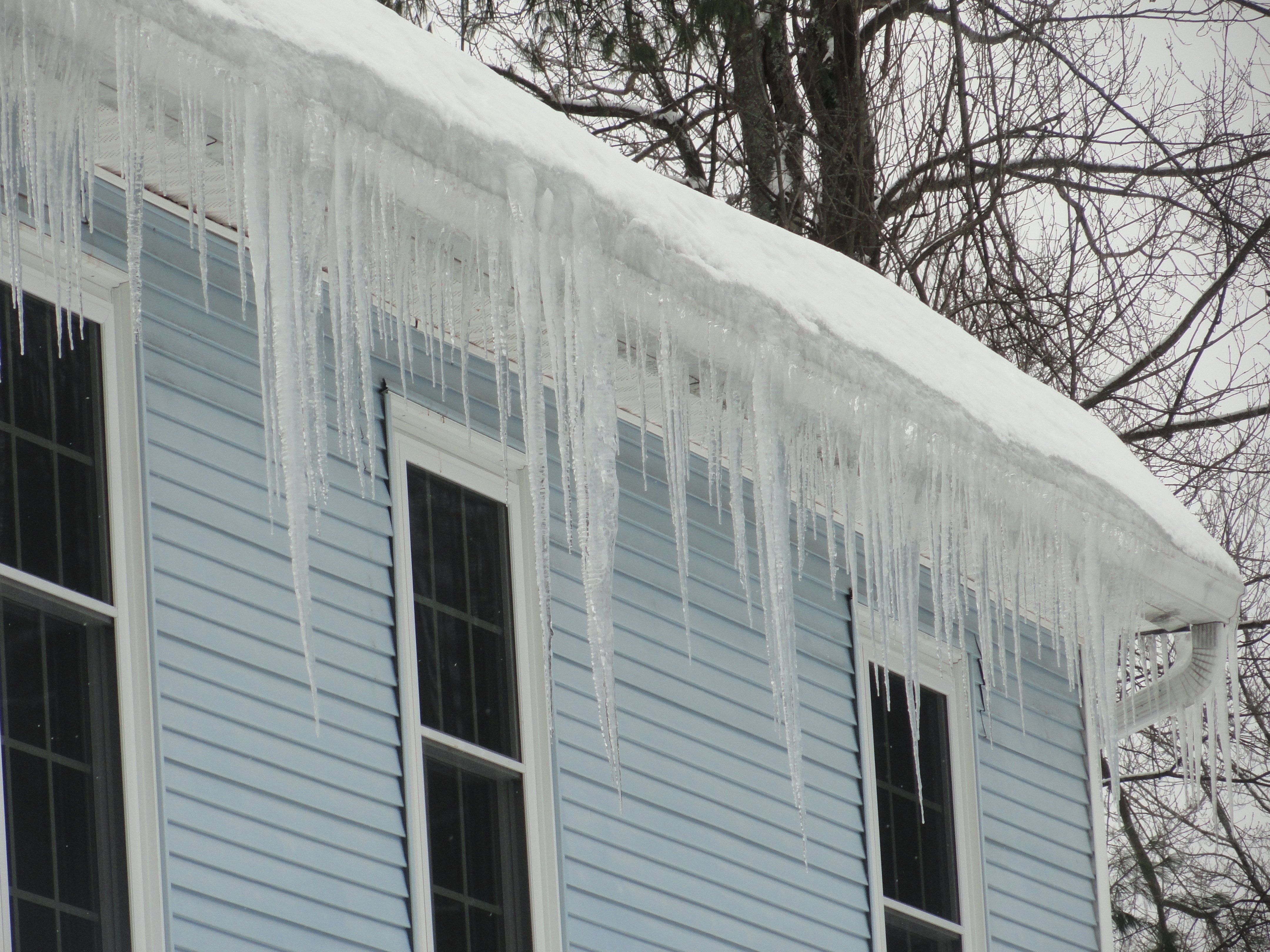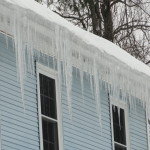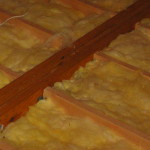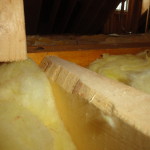
by Mike Quigley | Mar 8, 2014 | Blog
Attic mold usually starts at the rear of the house.
- The front of your house faces the street and the back faces the woods. Because of the location of your driveway and street, there probably aren’t as many trees in the front. Less trees equal less shade.
- The kitchen and baths are usually located at the rear of the house. This means your high moisture areas are located under the shadier, cooler section of the house.
- The pull down staircase is usually in the hall, right outside the bathroom and right down the hall from the kitchen. Any excess moisture from these areas will naturally be drawn into the attic around gaps in the cover. This upwards movement of air is called convection. In the summer when the attic is hotter, the downward movement of air is called migration.
- If you have an attic staircase, it should have a cover equal to or greater than the R-Value of the insulation.
When the sun comes up and starts to heat up the attic, the sunny warmer side pushes accumulated moisture in the attic to the cooler shadier side. Mold needs water to grow. If the plywood stays damp enough for long enough mold growth will begin. If you have a good attic ventilation system, that excess moisture will be drawn out of the attic. If you have a poor ventilation system water will condense on the roofing nails and eventually drip down on to your insulation.
If you combine mold spores, an edible surface (your attic plywood) and water you will grow mold. If left unchecked the mold spores will spread to the gable ends and eventually to the front section of the attic.
Here is a list of the common conditions leading to attic mold:
1) Cooking and showers.
2) Gas appliances.
3) Excess humidity from clothes dryers.
4) Fish tanks and plants.
5) Wet basements including open sump pump pits, dirt basements and foundation cracks.
6) Efflorescence caused by water infiltration into the basement usually due to improper yard grading.
7) Inadequate ventilation in the attic due to:
A) Blocked, missing or undersized soffit vents.
B) Blocked, missing or undersized ridge vent.
C) Blocked, missing or damaged soffit vent chutes.
8) Leaking ductwork due to improperly installed HVAC systems.
9) The bathroom fan venting into the attic or soffit.
10) The kitchen stove exhaust fan venting into the attic.
11) Improperly installed insulation including missing vapor barriers.
12) Ice dams.
13) Missing or undersized attic staircase cover.
14) Open chasses around pluming, light fixtures or chimney.
15) A lack of solar drying (trees and shrubs.)
16) Roofing, vent pipe flashings, skylights and chimney flashing leaks.
17) Plumbing and heating system leaks.

by Mike Quigley | Feb 21, 2014 | Blog
Ice dam formation is the result of continuous freezing and thawing of snow due to escaping heat from the house or from gutters being backed up with frozen slush. When this occurs, water may be driven under the roof which may cause ceiling, wall, insulation and gutter dam ventilating the attic. To help with water intrusion into your home, make sure you have six ft. of ice and water barrier under your roof shingles (measuring from the gutter line up.) Try to keep the edges clear with a snow rake. Install electric elements to help melt snow and ice on high roofs. Ice dams can be prevented from forming by: Installing a vapor barrier above the home’s warm space, insulating the attic floor and ventilating the attic.If water has found it’s way into your attic, you will probably see mold starting to grow along the lower edges of the roof. Do not let this go unattended as it will continue to migrate up the sheathing. Have the insulation and ventilation system upgraded and make sure you install an ice and water barrier if you are replacing the roof.


by Mike Quigley | Feb 19, 2014 | Blog
Why is there a hump in my floor?
There is a definite hump in the floor that is normally found in older homes. In older homes the foundation sinks leaving the center of the house higher. But this is a different problem.
Let’s say your house was built in 1985.Builders were combining engineered lumber with conventional lumber. Engineered lumber doesn’t shrink like conventional lumber. If you start with a 2 x 9.5 inch LVL (laminated veneer lumber) beam, 20 years later it’s still a 2 x 9.5” beam. However if you start with a standard 2×10 (which is really only 1.5” x 9.5”), 20 years from now it shrinks to 1.5” x 9.25”. So now your floors are all ¼” less than the height of the beam. The plywood that is nailed to the floor and stretches across the beam will now be humped up over the beam.
The solution is to remove the plywood directly over the beam and fill that area in with floor leveler or a thinner piece of plywood. Problem solved.

by Mike Quigley | Feb 18, 2014 | Blog
Well it is black mold, but it isn’t THE black mold that you think it is. The black mold you are referring to is STACHYBOTRYS CHARTUM.
In 1993 there was a story in Cleveland Ohio about infants dying from pulmonary hemorrhage and hemosiderosis. This was apparently caused by the introduction from the heating system of a mold called “STACHYBOTRYS CHARTUM” known today as the black mold. The hot air heating system return was located in the basement. The basement had water damage and the sheetrock in the basement grew mold. The mold spores were drawn into the system and distributed throughout the home via the supply ducts.
DEF: Stachybotrys is a slow growing, dark mold that grows well on cellulosic (paper-containing) building materials. It can produce a number of different macrocyclic trichothecenes which have been described as being toxic to humans and animals.
Stachybotrys is bigger than other molds, usually around 5.7 microns. (A micron is a millionth of a meter.) It is thick (think of tar), and it looks a little like shoe polish. It is aggressive and will dominate other molds. It is not readily airborne and is typically brought into the house on the bottom of your shoes. Typical mold spores are about 3.5 microns. To put that into perspective a human hair is about 75 microns thick. Cat and dog allergens along with dust mites are in the 0.3 to 1 micron range. Bacteria and lead dust are in the 1-3 micron range and skin flakes and pollen come in at around 3-10 microns.
Back to your problem, mold on the attic sheathing. Typical black mold in the attic, CLADOSPORIUM, (0.84-0.88%) is usually caused by vapor migration from the living space below (known as AW or water activity.) ALTERNARIA (0.89%) is typically from bath fans venting into the attic and ULOCLADIUM (also 89%) is typically caused by water leaks from around chimney and vent pipe flashing’s. I have never found stachybotrys growing on plywood. It simply isn’t the right substrate for encouraging this type of mold growth.
I say typically because attics seem to suffer from “all of the above.” It is usually a combination of vapor migration and under performing ventilation systems that allow mold to grow on the substrate (attic sheathing, plywood or boards.)
Mold cannot grow without water. Solve the water problem and you will solve the mold problem.




